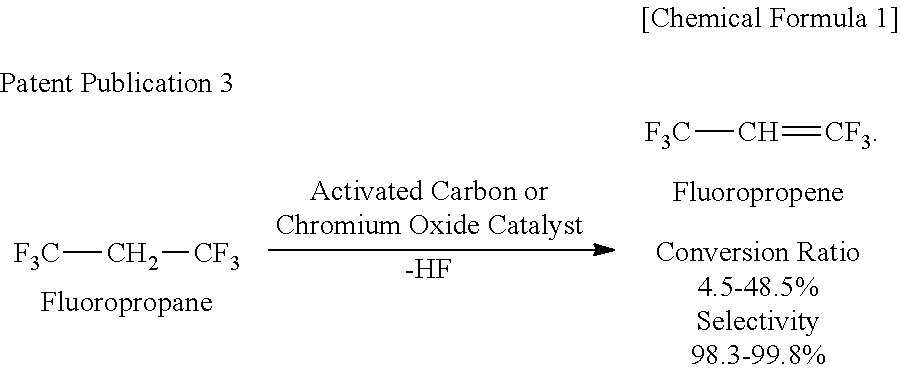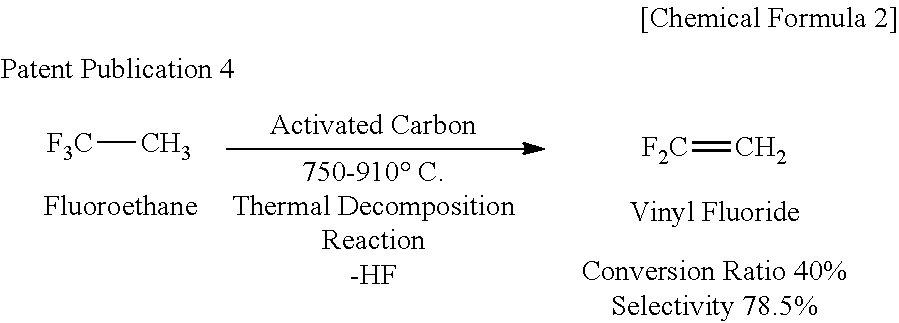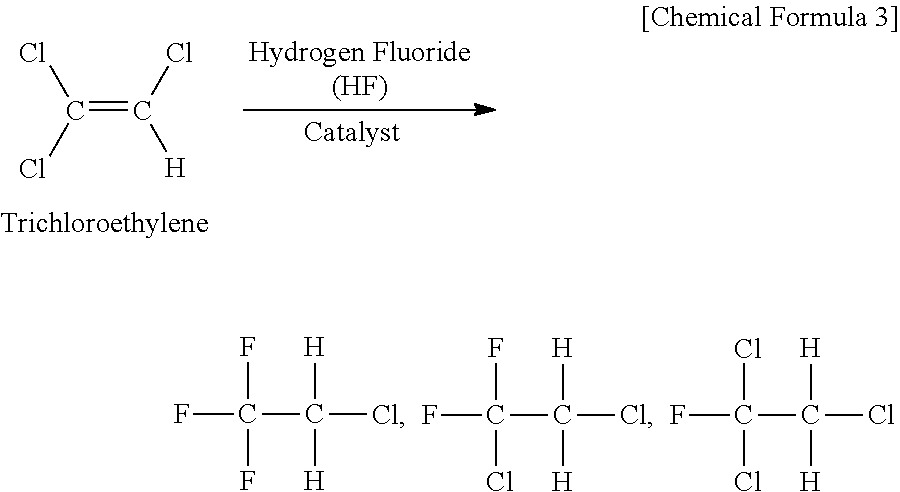Process for Producing 1,3,3,3-Tetrafluoropropene
a technology of tetrafluoropropene and tetrafluoropropene, which is applied in the field of process for producing 1, 3, 3, 3tetrafluoropropene, can solve the problems of unstable 1,3,3,3-tetrafluoropropene, and achieve the effects of high selectivity, high yield and improved conversion ratio and selectivity of 1-chloro-3,3,3-trifluoropropen
- Summary
- Abstract
- Description
- Claims
- Application Information
AI Technical Summary
Benefits of technology
Problems solved by technology
Method used
Image
Examples
preparation example 3
[0146]336 g of CrCl3.6H2O (a reagent chemical) was dissolved in pure water to be 1 L. Therein, 250 ml of granular γ-alumina having a diameter of 5 mm and a surface area of 340 m2 was immersed therein and set aside all day and night. Thereafter, γ-alumina was extracted by filtration and then kept in a hot wind-circulating dryer of 100° C., followed by being set aside a further day and night. A thus obtained chromium-carrying alumina was charged into a reaction tube equipped with an electric furnace and formed of a cylindrical SUS316L of 5 cm diameter and 30 cm length, followed by increasing the temperature up to 300° C. while feeding nitrogen gas. At a point when outflow of water could not be observed, hydrogen fluoride was associated with nitrogen gas and the concentration thereof was gradually increased. The reactor temperature was increased to 450° C. when a hot spot formed by fluorination of the charged chromium-carrying alumina reached the end of the outlet of the reaction tube,...
preparation example 4
[0147]A 1 liter glass flask was charged with 0.2 liter of granular palm husk charcoal (pelletizied “Shirasagi G2X” available from Japan EnviroChemicals, Ltd., 4 to 6 mesh) having a surface area of 1200 m2 / g and a pore diameter of 18 angstroms and then heated at 130 to 150° C., followed by removing water therefrom by a vacuum pump. At a point when distillate water could not be observed, nitrogen was introduced into the flask thereby bringing about atmospheric pressure.
Example 1
First Step: Production of 1-chloro-3,3,3-trifluoropropene
[0148]A pressure-resistant container having a capacity of 2000 ml and equipped with a reflux condenser tube, a pressure sensor and the like was charged with 217 g of 1,1,1,3,3-pentachloropropane (240fa) and then charged with 370 g of hydrogen fluoride, followed by setting a reactor control temperature at 160° C. and then heating up thereto. The pressure in the system grew higher together with proceeding of the reaction, due to generation of hydrogen fluor...
example 3
First Step: Production of 1-chloro-3,3,3-trifluoropropene
[0153]A preparatory step of Example 1 was repeated with the exceptions that the temperature of the reflux condenser was adjusted to 85 r and that 240fa was set to 1.7 g / min and hydrogen fluoride was set to 0.94 g / min. Thereafter, the reaction operation, the recovery operation and the analysis of Example 1 were repeated under a condition as shown in Table 1. Results thereof are shown in Table 1.
Second Step: Production of 1,3,3,3-tetrafluoropropene
[0154]Activated carbon was singly used on 1-Chloro-3,3,3-trifluoropropene obtained in the first step. The reaction operation, the recovery operation and the analysis of Example 1 were repeated under a condition as shown in Table 2. Results thereof are shown in Table 2.
PUM
| Property | Measurement | Unit |
|---|---|---|
| Temperature | aaaaa | aaaaa |
| Temperature | aaaaa | aaaaa |
| Temperature | aaaaa | aaaaa |
Abstract
Description
Claims
Application Information
 Login to View More
Login to View More - R&D
- Intellectual Property
- Life Sciences
- Materials
- Tech Scout
- Unparalleled Data Quality
- Higher Quality Content
- 60% Fewer Hallucinations
Browse by: Latest US Patents, China's latest patents, Technical Efficacy Thesaurus, Application Domain, Technology Topic, Popular Technical Reports.
© 2025 PatSnap. All rights reserved.Legal|Privacy policy|Modern Slavery Act Transparency Statement|Sitemap|About US| Contact US: help@patsnap.com



